it's-time-to-change-中职英语精华PPT课件
- 格式:ppt
- 大小:1.34 MB
- 文档页数:11
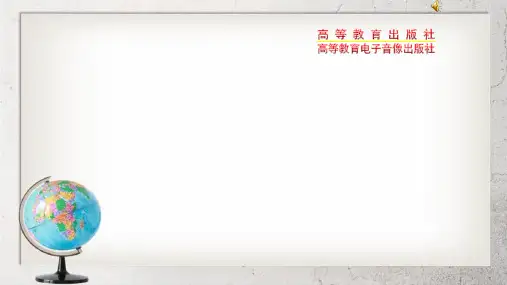
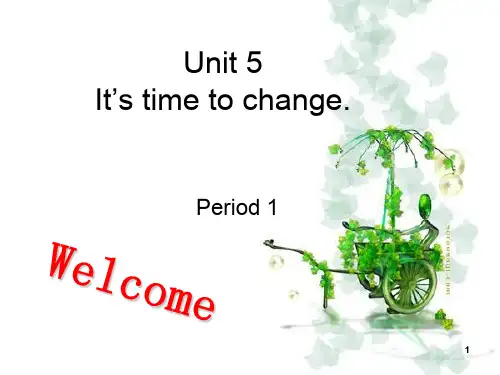

Unit 5 It’s time to change.(第一课时教学设计)一、学情分析本教案的授课对象为高二年级学生,班上女生占大多数英语基础参差不齐,学习积极性易调动但难以持久,通过多种课堂组织形式来调动她们的积极性,设计不同难易度的任务,唤起英语学习的欲望,从而达到教学目标。
二、教材分析1.教学内容本单元主要是关于生活习惯以及改变不良习惯的话题,该话题与学生的生活联系密切,能引起学生的共鸣。
第一课时的内容包括Lead-in & Listening and speaking两部分,主要内容是关于生活习惯及描述性形容词词汇和对话。
(1)教学重点①通过对图片的理解,能听懂有关生活习惯爱好及建议的词汇和句型。
②通过对话练习,学生能够就生活习惯等话题进行交流,并提出自己的建议。
(2)教学难点①学生能在真实的情境中运用与生活习惯有关以及提出建议的词汇和句型。
三、教学目标1.知识目标(1)学生能够掌握描述健康状况的词汇,如pale, weak ,fat, thin, sleepy, angry etc.(2)学生能够掌握有关周末计划的词组, 如:climb the mountain, do outdoor activities, watch TV, stay at home etc.(3)学生能掌握有关讨论生活习惯的句型,如:I’d rather……I prefer to……I like/love/enjoy……四、教学步骤Step One Lead-in ( 4 min )1.BrainstormingTeacher : “What activities are good for your healthy? What activities are bad for your healthy?Students : Compete with each other group and write the related phrases on the blackboard .Step Two Word Study (10 min)1.Matching gameTeacher: Choose the right adjectives to describe the pictures on the screen.Students: Work in individual s and match the words and related pictures.Step Three Listening (15min)1.Pre-listeningTeacher: Ask some students about their weekend activities.T: What do you usually do on weekends?OR Do you usually go out with your classmates?Do you usually stay at home?…S:……..2.While-listening(1)Listen and tickLead the students to look through the three topic words quickly, and askthem to tick what Tom and Sara are talking about.(2)Listen and completeStudents listen to the tape again and decide whether the statements aretrue or false, and then check them up in groups, if they can’t finish themthe first time, let the Ss listen to the tape again.(3)Listen and fill in the blanks.Listen again, and finish off the ex. Then check it though the whole class. Step Four: Speaking (15min)1. Revise weekends activities.Let Ss check up the weekend activities in pairs.2. Practice and act(1)First teacher makes short dialogues with several students. For example T: What do you like to do on weekends?S: I like……, what about you?T: I prefer to …. Do you enjoy……?S: Yes/ No.Students make dialogues in pairs, following the example. Then some of them act out their dialogue in front of the class.Step Five Homework (1min)1. Summarize the weekend activities phrases.2. Make up a new dialogue about your weekend activities with the partner.五、板书设计Unit 5 It ’s time to change.(第二课时 教学设计)一、教材分析1.教学内容本课时系教材《英语2》(基础模块 高教版)第五单元的第二课时,即Reading and Writing 部分。
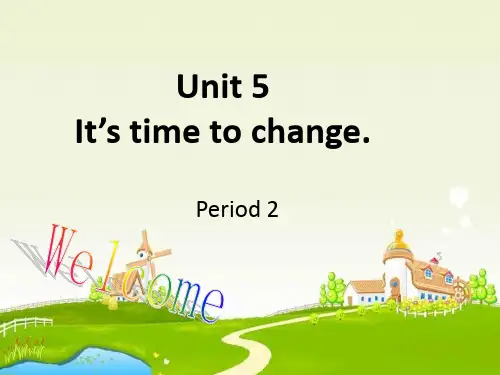
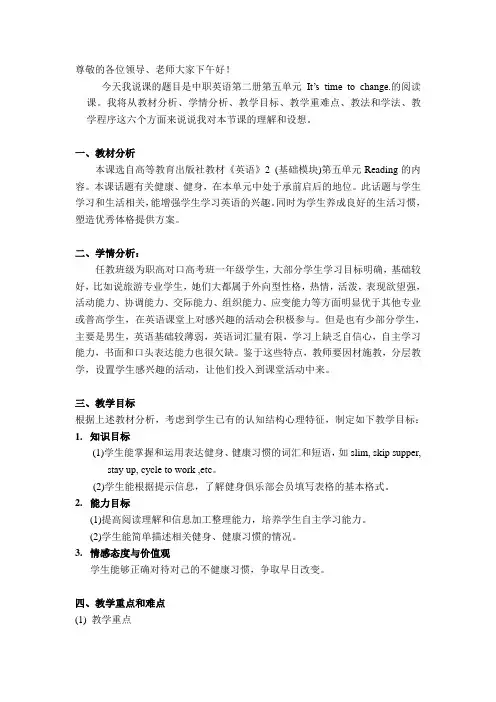
尊敬的各位领导、老师大家下午好!今天我说课的题目是中职英语第二册第五单元It’s time to change.的阅读课。
我将从教材分析、学情分析、教学目标、教学重难点、教法和学法、教学程序这六个方面来说说我对本节课的理解和设想。
一、教材分析本课选自高等教育出版社教材《英语》2 (基础模块)第五单元Reading的内容。
本课话题有关健康、健身,在本单元中处于承前启后的地位。
此话题与学生学习和生活相关,能增强学生学习英语的兴趣。
同时为学生养成良好的生活习惯,塑造优秀体格提供方案。
二、学情分析:任教班级为职高对口高考班一年级学生,大部分学生学习目标明确,基础较好,比如说旅游专业学生,她们大都属于外向型性格,热情,活泼,表现欲望强,活动能力、协调能力、交际能力、组织能力、应变能力等方面明显优于其他专业或普高学生,在英语课堂上对感兴趣的活动会积极参与。
但是也有少部分学生,主要是男生,英语基础较薄弱,英语词汇量有限,学习上缺乏自信心,自主学习能力,书面和口头表达能力也很欠缺。
鉴于这些特点,教师要因材施教,分层教学,设置学生感兴趣的活动,让他们投入到课堂活动中来。
三、教学目标根据上述教材分析,考虑到学生已有的认知结构心理特征,制定如下教学目标:1.知识目标(1)学生能掌握和运用表达健身、健康习惯的词汇和短语,如slim, skip supper,stay up, cycle to work ,etc。
(2)学生能根据提示信息,了解健身俱乐部会员填写表格的基本格式。
2.能力目标(1)提高阅读理解和信息加工整理能力,培养学生自主学习能力。
(2)学生能简单描述相关健身、健康习惯的情况。
3.情感态度与价值观学生能够正确对待对己的不健康习惯,争取早日改变。
四、教学重点和难点(1) 教学重点①学会使用stay up, get rid of等5个词组和掌握I think I can becomeslimmer next month.等5个宾语从句。
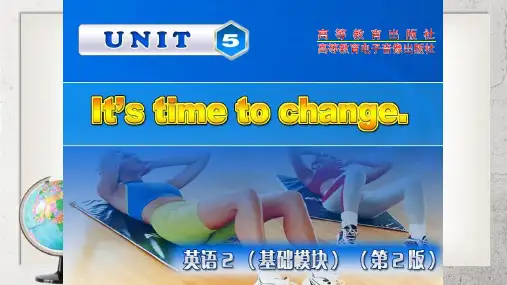

课程英语班级任课教师—I’m not sure. Maybe a teacher.A. whenB. howC. whereD. what6.—What did your parents think about your advice?--They always let me do _______I think I should.A. whenB. thatC. howD. what8. I want to know ________.A. when we should arrive at the airportB. when should we arrive at the airportC. when the airport we should arrive atD. when the airport should we arrive at9. --Would you please tell me __________?--At 10:00 this evening.A. when will the train leaveB. when the train will leaveC. when does the train leave10. –Do you know ________ the man with sunglasses is?-I’m not sure. Maybe a reporter.A. whoB. whatC. whereD. how11. -Tommy, do you know if Frank ________ to the zoo this Sunday if it ________? -Sorry, I have no idea.A.will go; is fineB. goes; is fineC. will go; is going to be fineD. goes; will be fine13. No one can be sure_________ in a million years.A. what man looks likeB. what will man look likeC. what man looked likeD. what man will look like14. Sue told me that she _________ shopping with her sister the next day.A. will goB. would goC. goesD. has gone15. The new-designed(新设计的) car is on show now. I want to know _________.A. how much it costB. how much did it costC. how much it costsD. how much does it cost16. –Can you tell me when ________?-About half past five. I will pick him up at the airport.A. he will comeB. will he comeC. did he comeD. he came17. Our teacher told us the sun ________ in the east.A. riseB. roseC. risingD. rises18. --Listen! It is still noisy in the teacher’s office.-Go and see ________ they have finished correcting the papers yet.A. thoughB. whetherC. unlessD. while19. -What time will Mr. Brown be back to China?-Sorry. I don’t know ________.A. when did he go abroadB. why he is going abroadC. how soon will he be backD. how long he will stay abroad20. .—What did you say just now? —I asked _______.A. that I could open the doorB. could I open the doorC. how could I open the doorD. how I could open the door。
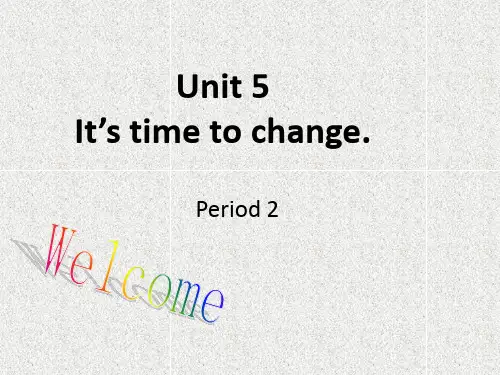

课程英语班级任课教师—I’m not sure. Maybe a teacher.A. whenB. howC. whereD. what6.—What did your parents think about your advice?--They always let me do _______I think I should.A. whenB. thatC. howD. what8. I want to know ________.A. when we should arrive at the airportB. when should we arrive at the airportC. when the airport we should arrive atD. when the airport should we arrive at9. --Would you please tell me __________?--At 10:00 this evening.A. when will the train leaveB. when the train will leaveC. when does the train leave10. –Do you know ________ the man with sunglasses is?-I’m not sure. Maybe a reporter.A. whoB. whatC. whereD. how11. -Tommy, do you know if Frank ________ to the zoo this Sunday if it ________? -Sorry, I have no idea.A.will go; is fineB. goes; is fineC. will go; is going to be fineD. goes; will be fine13. No one can be sure_________ in a million years.A. what man looks likeB. what will man look likeC. what man looked likeD. what man will look like14. Sue told me that she _________ shopping with her sister the next day.A. will goB. would goC. goesD. has gone15. The new-designed(新设计的) car is on show now. I want to know _________.A. how much it costB. how much did it costC. how much it costsD. how much does it cost16. –Can you tell me when ________?-About half past five. I will pick him up at the airport.A. he will comeB. will he comeC. did he comeD. he came17. Our teacher told us the sun ________ in the east.A. riseB. roseC. risingD. rises18. --Listen! It is still noisy in the teacher’s office.-Go and see ________ they have finished correcting the papers yet.A. thoughB. whetherC. unlessD. while19. -What time will Mr. Brown be back to China?-Sorry. I don’t know ________.A. when did he go abroadB. why he is going abroadC. how soon will he be backD. how long he will stay abroad20. .—What did you say just now? —I asked _______.A. that I could open the doorB. could I open the doorC. how could I open the doorD. how I could open the door。
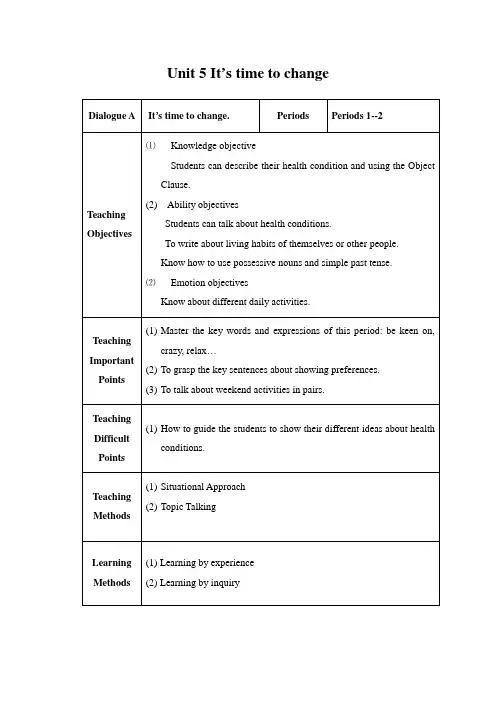
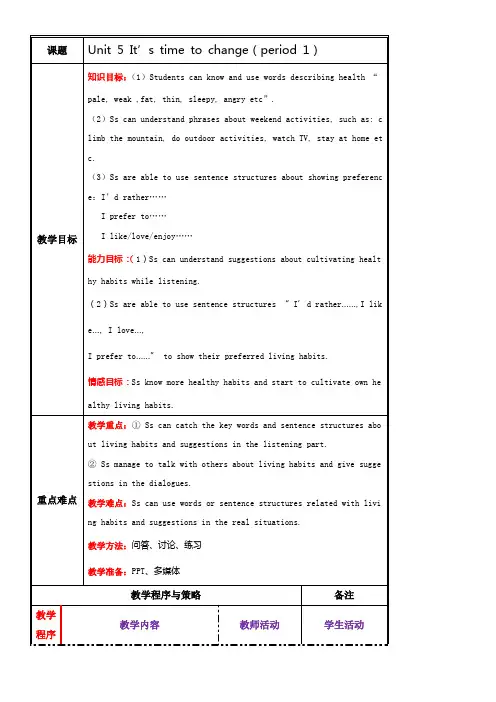
课题Unit 5 It’s time to change(period 1)教学目标知识目标:(1)Students can know and use words describing health “ pale, weak ,fat, thin, sleepy, angry etc”.(2)Ss can understand phrases about weekend activities, such as: c limb the mountain, do outdoor activities, watch TV, stay at home et c.(3)Ss are able to use sentence structures about showing preferenc e:I’d rather……I prefer to……I like/love/enjoy……能力目标:(1)Ss can understand suggestions about cultivating healt hy habits while listening.(2)Ss are able to use sentence structures “ I’d rather……,I lik e…, I love…,I prefer to……” to show their preferred living habits.情感目标:Ss know more healthy habits and start to cultivate own he althy living habits.重点难点教学重点:① Ss can catch the key words and sentence structures abo ut living habits and suggestions in the listening part.② Ss manage to talk with others about living habits and give sugge stions in the dialogues.教学难点:Ss can use words or sentence structures related with livi ng habits and suggestions in the real situations.教学方法:问答、讨论、练习教学准备:PPT、多媒体教学程序与策略备注教学程序教学内容教师活动学生活动Step OneLead -inStep Two Wor d Stud y Step Thre e Liste ning StepT w oR e a ding skil lsSte p Fou r: Spe akin g 1.Simple greetings and askingquestions to lead-in the topic.What did you do last weekend?2.Small discussion aboutteacher’s weekend activities.I did five things lastweekend.Do you think which ishealthy? Which is unhealthy?If I eat too much ice cream,drink too much beer, what willhappen to me?---fatIf I do too muchhomework, what will Ifeel?---sleepy1.Matching gameLet students choose the rightadjectives to describe thepictures on the screen.2.Discussion and matchDiscuss how they can keephealthy. Match thesuggestions with the picturesin Activity 1.1.Pre-listeningAsking severalstudents questionsabout doing outdoorthere are four people having problems in their health. Let’s look atpictures and findout what are they?explain the meaning of “do more outdoor activities”.For example, climbing the mountainand going boating are outdoor activities.Now, there are two students Tom and Sara talking about what they will do this weekend.check it through the whole class.Act with severalSs as an exampleMake an examplefor Ss to referenceStudents work in individual s and then check the answers together.Students read afterthe tape sentenceby sentence, and then underline thesentences showingpreferences.Practice and act inpairsDo you often dooutdoor activities or doyou often stay athome?2. While-listening(1)Listen and answer questions Listen to the tape for the first time and find out who will climb the mo untain and who will stay at home t his weekend.(2)Listen and completeStudents listen to the tape again and decide whether the statements are t rue or false. If it is false, find out t he reasons.(3)Listen and fill in the blanks.Listen again, and fill in the bl anks with the words in the box.3. Post-listening(1)Read and underline.(2) Let Ss find out these sentences and teacher lists sentence structures in the blackboard.1. Practice and act: talk about week end activities in pairs(1)First teacher makes short dial ogues with several students. For exa mple:T: What do you like to do on wee kends?S: I like……, what about you?T: Well, I prefer to ….(2) Students make dialogues in pairs, following the example. Then s ome of them act out their dialogue i n front of the class.2. Discussion and make a report Students in groups of four discuss t he activities which are bad for healt h and talk about the reasons using l earned adjectives. Students make a r eport as follows:Report:I think……is unhealthy, becaus e…….. So I like/love/enjoy/prefer t o………小结第一课时的内容包括Lead-in & Listening and speaking两部分,主要内容是关于生活习惯及描述健康状况的形容词词汇和表达习惯爱好的对话。
It 's time to change.Lead-in (Page 73 Activity 1) (文化背景知识,教师可为学生讲解汉堡包的由来,用和学生生活相关的事物介绍单词的记忆方法) 汉堡包,被称为西方五大快餐之一,如何起源的呢?原始的汉堡包是剁碎的牛肉末和面做成的肉饼,故称牛肉饼。
古代鞑靼人有生吃牛肉的习惯,随着鞑靼人的西迁,先传入巴尔干半岛,而后传到德意志,逐淅改生食为熟食。
德国汉堡地区的人将其加以改进,将剁碎的牛肉泥揉在面粉中,摊成饼煎烤来吃,遂以地名而称为“汉堡肉饼”。
1850 年,德国移民将汉堡肉饼烹制技艺带到美国。
1932 年有人将这种油炸牛肉饼夹入表面撒有芝麻的小圆面包中作为主食或点心食用,后来花样翻新,逐渐与三明治合流,将牛肉饼夹在一剖为二的小面包当中,所以得名汉堡包,意为有汉堡牛肉饼的面包。
汉堡包一词为英语 Hamburger 的中文名,同时含有音译及意译的元素在内,有时也直接称为汉堡。
汉堡包原名来自于德国的城市汉堡市(Hamburg)。
在英语里头, Hamburger 就是指“来自汉堡的” ,可以是指汉堡包本身,或是包里面由牛绞肉或其他夹有牛绞肉做成的肉饼。
这一种肉饼,现时在汉语普遍称之为汉堡排,而汉堡包则用来专指夹了汉堡排的圆包三明治。
Hamburger 这个名字起源于德国西北城市汉堡( Hamburg),今日的汉堡是德国最为繁忙的港口,在 19 世纪中叶的时候,居住在那里的人们喜欢把牛排捣碎成一定形状,这种吃法可能被当时的大量德国移民传到了美洲。
1836 年,一道以“汉堡牛排”(Hamburg steak)命名的菜出现在美国人的菜单上;从一本1902 年的烹饪手册中我们可以看出,当时 Hamburg steak 的做法与今天的概念已经很接近了,就是用碎牛肉和洋葱与胡椒粉拌在一起。
到了 20 世纪晚期,美国人对 Hamburg steak的做法进行了改良,然后把它送进了快餐店,这就是今天招人喜爱的 hamburger 的起源。